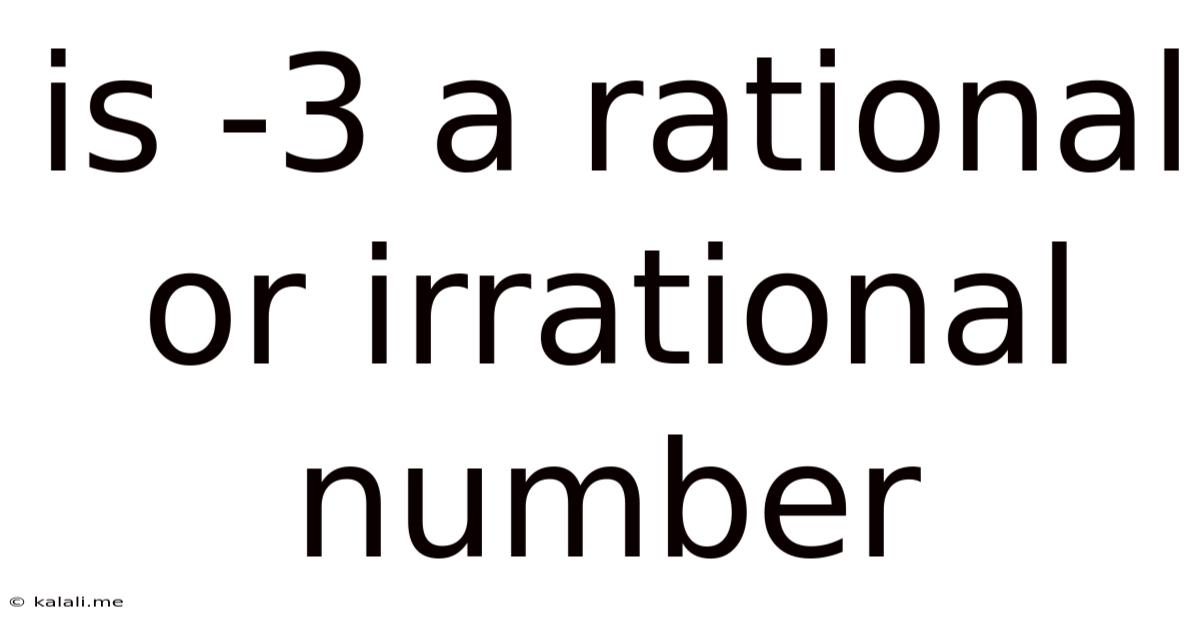Is -3 A Rational Or Irrational Number
Kalali
Apr 19, 2025 · 4 min read

Table of Contents
Is -3 a Rational or Irrational Number? A Comprehensive Exploration
Is -3 rational or irrational? This seemingly simple question delves into the fundamental concepts of number systems in mathematics. Understanding the distinction between rational and irrational numbers is crucial for anyone studying mathematics, from high school students to advanced undergraduates. This article provides a comprehensive explanation, clarifying the definition of both rational and irrational numbers, exploring the properties of -3, and ultimately answering the question definitively. We'll also delve into related concepts and provide practical examples to solidify your understanding.
What are Rational Numbers?
A rational number is any number that can be expressed as a fraction p/q, where p and q are integers, and q is not equal to zero. The key here is the ability to represent the number as a ratio of two whole numbers. This definition encompasses a wide range of numbers, including:
- Integers: Whole numbers, both positive and negative, including zero. Examples: -3, 0, 5, 100.
- Fractions: Numbers expressed as a ratio of two integers. Examples: 1/2, 3/4, -2/5, 7/1.
- Terminating Decimals: Decimals that have a finite number of digits. Examples: 0.5 (1/2), 0.75 (3/4), -0.2 ( -1/5).
- Repeating Decimals: Decimals that have a pattern of digits that repeats infinitely. Examples: 0.333... (1/3), 0.666... (2/3), 0.142857142857... (1/7).
What are Irrational Numbers?
Irrational numbers are numbers that cannot be expressed as a fraction p/q, where p and q are integers, and q is not zero. These numbers have decimal representations that are non-terminating and non-repeating. This means their decimal expansions go on forever without any predictable pattern. Famous examples of irrational numbers include:
- π (Pi): The ratio of a circle's circumference to its diameter, approximately 3.14159...
- e (Euler's number): The base of the natural logarithm, approximately 2.71828...
- √2 (Square root of 2): The number that, when multiplied by itself, equals 2, approximately 1.41421...
- The Golden Ratio (φ): Approximately 1.61803...
Understanding the Properties of -3
Now let's focus on the number -3. Can we express -3 as a fraction p/q, where p and q are integers, and q ≠ 0? The answer is a resounding yes. Here are several ways to represent -3 as a rational number:
- -3/1: This is the most straightforward representation. Both -3 and 1 are integers, and the denominator is not zero.
- -6/2: This is an equivalent fraction. -6 and 2 are integers, and the denominator is not zero.
- -9/3: Another equivalent fraction, demonstrating that there are infinitely many ways to represent -3 as a rational number.
Since we can easily express -3 as a ratio of two integers (-3/1, for example), it unequivocally fits the definition of a rational number. Its decimal representation is simply -3.0, which is a terminating decimal.
Why -3 is NOT an Irrational Number
The defining characteristic of irrational numbers is their inability to be expressed as a fraction of two integers. Because we've shown multiple ways to represent -3 as such a fraction, it immediately disqualifies it from being classified as irrational. Its decimal representation, -3.0, is finite and therefore doesn't possess the infinite, non-repeating decimal expansion that is the hallmark of irrational numbers.
Further Exploration: The Number Line and Number Sets
The real number system encompasses both rational and irrational numbers. You can visualize this on a number line. The rational numbers are densely packed along the line, meaning you can always find a rational number between any two given rational numbers. However, the irrational numbers fill in the gaps between the rational numbers, making the real number line continuous.
The relationship between different number sets can be summarized as follows:
- Natural Numbers (N): {1, 2, 3, 4...} Positive whole numbers.
- Whole Numbers (W): {0, 1, 2, 3, 4...} Natural numbers plus zero.
- Integers (Z): {...-3, -2, -1, 0, 1, 2, 3...} Whole numbers and their negatives.
- Rational Numbers (Q): Numbers that can be expressed as p/q, where p and q are integers, and q ≠ 0. This includes all integers, fractions, terminating and repeating decimals.
- Irrational Numbers (I): Numbers that cannot be expressed as p/q, where p and q are integers, and q ≠ 0. This includes numbers like π, e, √2.
- Real Numbers (R): The union of rational and irrational numbers. This encompasses all numbers that can be plotted on a number line.
Conclusion: -3 is definitively a Rational Number
In conclusion, based on the rigorous definition of rational and irrational numbers, -3 is unequivocally a rational number. It can be expressed as a fraction of two integers, its decimal representation is terminating, and it lacks the infinite, non-repeating decimal expansion characteristic of irrational numbers. Understanding this distinction is crucial for mastering fundamental mathematical concepts and further exploring more advanced areas of mathematics. This article has not only answered the initial question but provided a deeper understanding of number systems, their properties, and the key differences between rational and irrational numbers. By grasping these core concepts, you build a solid foundation for future mathematical endeavors.
Latest Posts
Latest Posts
-
How Much Is 3 Fluid Oz
Apr 22, 2025
-
What Is 122 Cm In Inches
Apr 22, 2025
-
What Percentage Is 15 Out Of 18
Apr 22, 2025
-
What Percentage Of 30 Is 6
Apr 22, 2025
-
How Tall Is 60 Cm In Feet
Apr 22, 2025
Related Post
Thank you for visiting our website which covers about Is -3 A Rational Or Irrational Number . We hope the information provided has been useful to you. Feel free to contact us if you have any questions or need further assistance. See you next time and don't miss to bookmark.